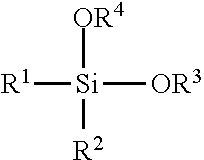Resin-rubber composite
- Summary
- Abstract
- Description
- Claims
- Application Information
AI Technical Summary
Benefits of technology
Problems solved by technology
Method used
Image
Examples
example 1
[0037]A plate-like injection molded product (25×60×2 mm) made of polyamide (PA66; Amilan CM3001-G30, produced by Toray Industries, Inc.) was treated with low pressure plasma in a glass vacuum vessel equipped with aluminum parallel plates under the following conditions:[0038]Atmosphere: helium gas[0039]Pressure: about 60 Pa[0040]Frequency: 40 kHz[0041]Output: 200 W[0042]Time: 10 minutes
[0043]A kneaded product of a higher fatty acid metal salt-sulfur vulcanizable acrylic rubber composition of the following Formulation Example was directly bonded, in an unvulcanized state, to one surface of the low pressure plasma-treated polyamide plate, followed by press vulcanization at 180° C. for 8 minutes, thereby producing a resin-rubber composite:
formulation example i
[0044]
Chlorine group-containing acrylic rubber100parts by weight(PA-402K, produced by Unimatec Co., Ltd.)HAF carbon black (produced by Cabot Japan55parts by weightK.K.)Stearic acid (produced by Miyoshi Oil &1part by weightFat Co., Ltd.)Alkoxysilane0.5parts by weight(γ-aminopropyltriethoxysilane; produced byDow Corning Toray Silicone Co., Ltd.)Antioxidant (Naugard 445, produced by2parts by weightCHEMTURA)Mold-releasing agent (Struktol, produced by2parts by weightSchill & Seilacher)Vulcanization accelerator (sodium stearate;3parts by weightNS Soap, produced by Kao Corporation)Vulcanization accelerator0.25parts by weight(potassium stearate; Nonsoul SK-1,produced by NOF Corporation)Sulfur0.3parts by weight
[0045]The obtained resin-rubber composite was measured for the adhesive strength and rubber-remaining area ratio by a 90-degree peel test according to JIS K6256 (2006) corresponding to ISO 813 as adhesiveness evaluation.
example 2
[0046]In Example 1, as a higher fatty acid salt-sulfur vulcanizable acrylic rubber composition, Formulation Example I that did not contain any silane compound was used.
PUM
| Property | Measurement | Unit |
|---|---|---|
| Pressure | aaaaa | aaaaa |
Abstract
Description
Claims
Application Information
 Login to view more
Login to view more - R&D Engineer
- R&D Manager
- IP Professional
- Industry Leading Data Capabilities
- Powerful AI technology
- Patent DNA Extraction
Browse by: Latest US Patents, China's latest patents, Technical Efficacy Thesaurus, Application Domain, Technology Topic.
© 2024 PatSnap. All rights reserved.Legal|Privacy policy|Modern Slavery Act Transparency Statement|Sitemap

